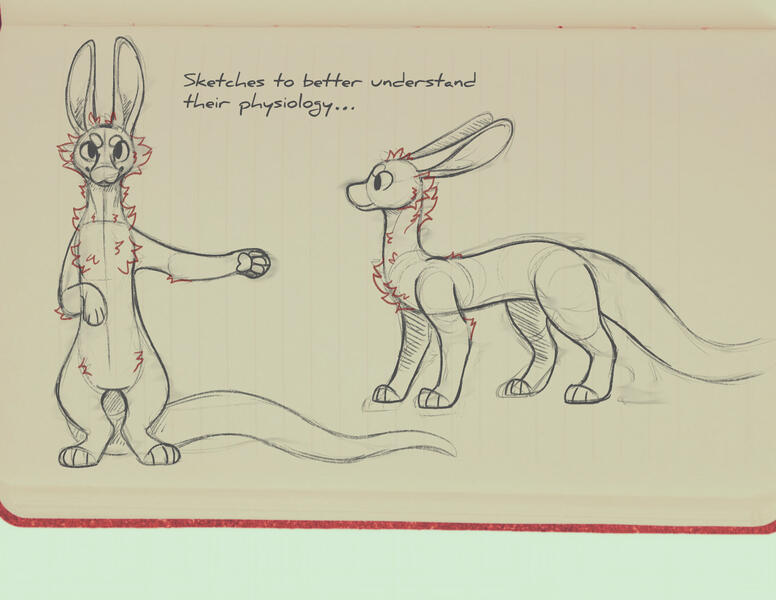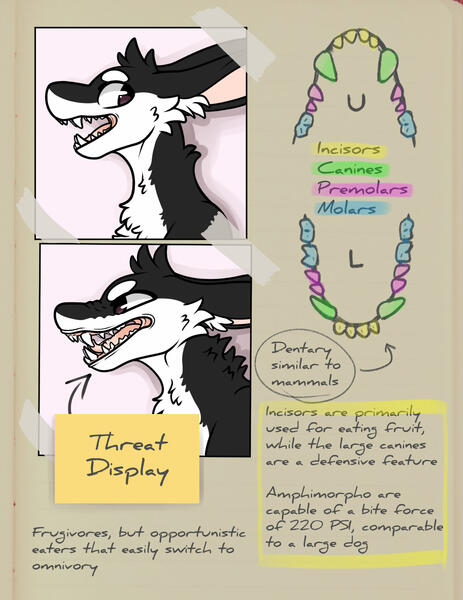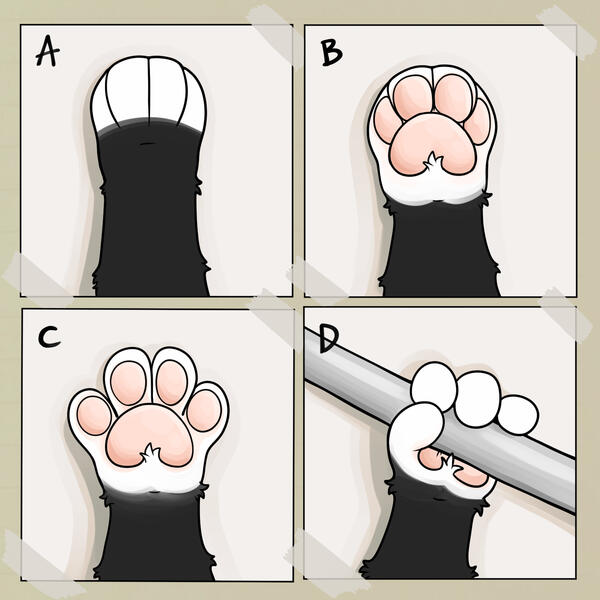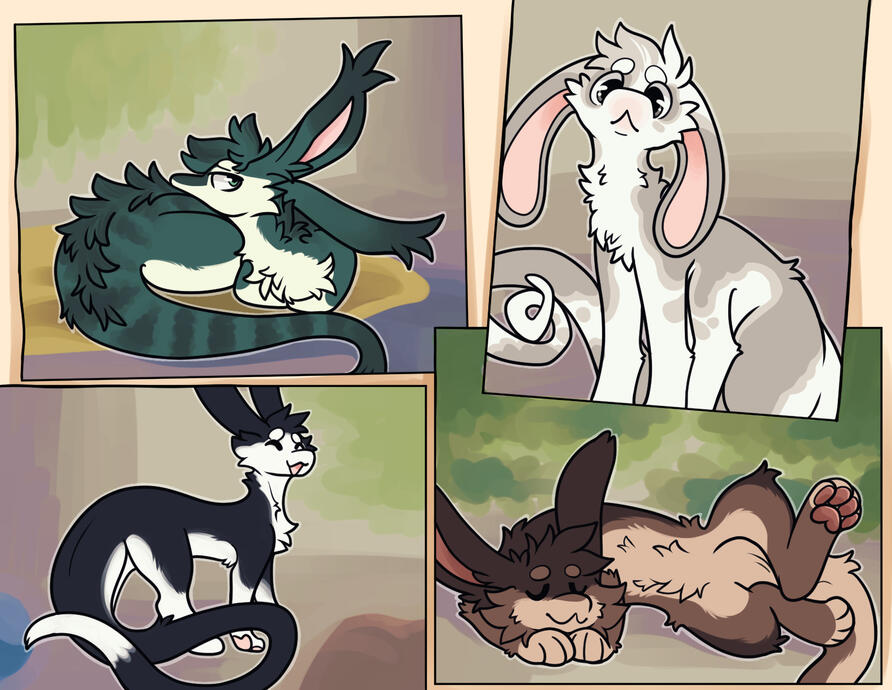"Amphimorpho? Like the book series?"
Nope! "Amphimorpho" like the noodle-shaped shapeshifting aliens! Never heard of them, or otherwise curious to learn more? You're in the right place!Amphimorpho or "tuxedo dragons" are a fictional open species that feature prominently in my webcomic Meet Me in the Woods and the focus of a world-building project of several years! This website is to share lore on the species, for anyone who'd like to make one of their own or is simply curious to know more about these critters!
Species info
Proteus amphimorpho is the name given to the creatures initially engineered as part of Project Delta's unique approach to studying cellular regeneration, combining Earthen genetics with an alien genome to create something new.
Amphimorpho were not meant to grow into the complexity that they have; their creation and subsequent growth, however, can’t be written off as a mistake either. The development from engineered test subject to a thriving population of new, unique species is a marvel of science and nature, completely unprecedented. It might be too sentimental of a statement to call it a beautiful thing, but it’s been written there now.
Description
A basal form amphimorpho resembles a mammalian creature with a long, serpentine body with 4 or 6 limbs (one or two sets of front limbs and one set of hind limbs), a strong and prehensile tail with a thick base that tapers off towards the end, a head with a round snout lacking nostrils, and rabbit-like ears capable of pivoting independent of each other. Most individuals also possess a belly pouch; this may be a vestigial trait, as it does not appear to serve any vital purpose.
The average length of a full-grown amphimorpho is about 1.8 - 2 m (6 - 7 ft) from snout to rear, and the tail is anywhere between 1.5 - 2x that length. They are surprisingly lightweight for an organism their size, typically not reaching more than 115 kg (~250 lbs).
Amphimorpho are arboreal animals with several adaptions for this lifestyle; their large, semi-dexterous paws are able to cling to most surfaces, allowing them to scale trees and smooth walls alike with ease, and they possess large, forward-facing eyes that give them exceptional depth perception. Their bodies are also extremely flexible, and the prehensile tail acts as an extra limb to grab onto tree branches.
Their bodies are covered in a soft, dense fur that comes in a variety of patterns, but most commonly has a bi-colored, countershaded scheme (“tuxedo” patterning, hence the species’ nickname). They can change their colors rapidly and with ease, and it's possible that some individuals use this to communicate.
Taxonomy
As with many other alien species that were discovered on Terranova, the taxonomic classification has yet to be confirmed for amphimorpho, in large part due to uncertainty of how to classify alien organisms under human-made taxonomic parameters. Thus far, they can be grouped under the class Neomammalia together with other, similar alien species. Their status as chimeras, however, further complicates this process.A temporary classification has been suggested, placing them in the family Chamaeleopsidae and genus Proteus together with their origin species, P. protomorpho, as they share anywhere between 75 - 90% of the same DNA and are physically similar in appearance.All names, with the exception of species names, are subject to change once a consensus on alien classifications can be reached.
Etymology
Amphimorpho is both the taxonomic and common name of the species, and is derived from the Greek words ἀμφί (amphí), meaning “both sides”, and μορφή (morphḗ), meaning shape or form. Other names the species is referred to include the shortened “morpho” and the nickname “tuxedo dragon”, alluding to the common coat pattern many display. The final name was chosen after suggestions were taken from crew members on the Infinity Research Station involved with or with connections to Project Delta.
Behavior
In general, amphimorpho are described as being playful, curious, affectionate, and expressive creatures, though it should also be noted that they display a range of personalities comparable to humans. They are intelligent to the point of being sapient, having shown an ability to reason, process, and communicate on the same level as most human beings. This is likely because of their genetic makeup, which has a handful of sapient species crossed into the mix.They've commonly been noted to be eager learners, and may pick up on certain tasks, activities, or mannerisms very quickly. They’ve even been reported to mimic their human caretakers down to expressions and movements, which some might find either comical or irritating.They can make and use tools and be trained to do complex tasks, most notably farming and caring for other organisms. They can also be taught difficult concepts such as mathematics and language, and have additionally been shown to learn these complex skills from one another. On their adopted home planet Terrarium, they've shown a capacity for building up societal structures and a culture of their own.Amphimorpho get along extremely well with their own kind as well as other species. They’ve been observed bonding with dogs, cats, and rats, and seem to easily adapt to reading these organisms’ behavior patterns. They interact with humans on a level that might suggest that they see themselves as equals, and subsequently enjoy working alongside and helping their human companions, even forming strong emotional bonds with them.With their own kind, amphimorpho are generally very social and form groups of many individuals, called a “suit”, “social”, or “gala”. A lone amphimorpho is often anxious and fearful, and will seek out companionship wherever possible. The desire to form groups with others is likely a residual instinct from P. protomorpho, a prey animal whose safety depends on staying together as a colony.Amphimorpho are rarely aggressive, and have been observed to attack only in pressing situations where they may feel trapped and threatened. More often than not, they prefer to flee from danger, and are known to be excellent escape artists.
Shapeshifting
The ability amphimorpho are best known for – what they were engineered for, even – is the nearly limitless power to physically alter their bodies into any shape, organism, or object under the sun! While this was initially meant to just enhance their already powerful regenerative healing ability, Project Delta was able to push this to an extreme as of yet not wholly explainable by current scientific knowledge.Their cells are incredibly flexible and fluid, and at their core resemble stem cells in many ways. Unlike regular stem cells, however, these cells are able to slip back and forth between different cell types, adjusting as needed to accommodate whatever shape the amphimorpho wishes to take.An amphimorpho’s cells remain in a semi-liquid state most of the time, which is thought to give the cells greater flexibility and speed in changing forms, as well as allowing signals to pass from cell to cell much faster than in many other organisms. It also allows for stored sugars – the primary source of energy that fuels amphimorphos’ cells – to more quickly pass through the system and provide a rapid boost to cells during a shapeshifting event.Their cells also have another unique feature to further help when changing into other species specifically, through a process called “imprinting”. When an amphimorpho comes into physical contact with another DNA-carrying organism, its cells are able to “read” the other organism’s cells and create a sort of genetic memory of its DNA.There are certain limits to the amphimorphos’ incredible ability. They cannot, for example, become endlessly large or small, constrained to the limits at which their body can either safely compact/expand their mass a/o convert that mass into energy to be released or stored. They may also find trouble trying to shift into something based merely on description. They are also able to shift based on visual reference only, but this will result in a form which only mimics the outward appearance of an organism; in other words, they will still retain their original inner workings, and may not be able to mimic the original organism as well as if they’d imprinted on it instead.Another limit is whether or not their body has enough energy stored to begin with in order to carry out a physical change. Shapeshifting requires massive amounts of energy beyond simple changes such as color, which an amphimorpho typically remedies with a diet rich in calories. If they do not have access to enough calories, or are severely injured or ill, they will find it difficult to shift, or hold a different form.
FAQ
Can I make my own? Yes! Amphimorpho are an open species, you're free to make as many as you'd like!
What about adoptables? That's also fine! Please be sure to credit me for the species, however! I also ask that any adoptables not be made on my free-to-use bases!
Do they have to follow canon? Not necessarily! At their core, they're simply shapeshifting creatures, and I think they'd adapt nicely to whatever settings and stories you have in mind for them!
Is NSFW content of them allowed? Yep! It's not really any of my business what you do with your characters, go nuts!
Resources
Here's a couple of free bases you can use! Please don't forget to credit me for them, and please do not use them to create adoptables!
Want to read more about them? I've got additional documents with miscellaneous headcanons and worldbuilding material for those interested!
Want to read a webcomic with noodles in it?? Meet Me In The Woods is a sci-fi mystery featuring these funky aliens by me, and it's free to read online!
Contact

Hey, I'm Theo or Tux! I'm a nonbinary biologist and artist, and the creator of this silly species!Wanna get in touch or stay updated on my stuff? You can find me elsewhere at the links below!
Oh, you found my page...welcome. No one's supposed to know about this, but if you're here then maybe it's already too late and you're infected.
PROJECT DELTA tried to splice portions of the amphimorpho genome into other organisms via a viral vector, which had...interesting results. Instead of something useful, they created a pathogen capable of completely rewriting the host's genome. A human infected with the AMPHIMORPHO VIRUS is no longer human on the biological level, but hey, you probably already knew that, right?
Once that got out, PROJECT DELTA was supposed to shut down. Somehow, they've persisted, and the virus has breached quarantine from their labs, and that's probably what landed you here.





